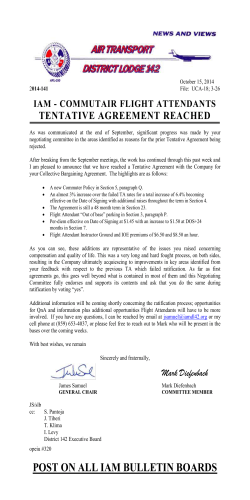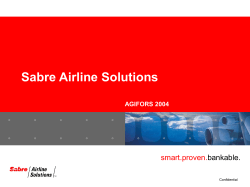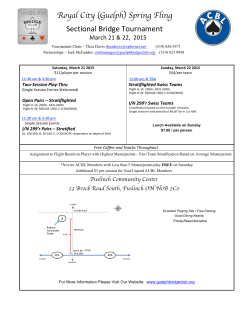
Draft CAR Section 8 Series F Part V
GOVERNMENT OF INDIA OFFICE OF THE DIRECTOR GENERAL OF CIVIL AVIATION TECHNICAL CENTRE, OPP. SAFDARJUNG AIRPORT, NEW DELHI – 110003 CIVIL AVIATION REQUIREMENT SECTION 8 – AIRCRAFT OPERATIONS SERIES 'F', PART V ISSUE I, Dated ________ 2015 EFFECTIVE: ______________ File No. AV-22024/09/2015-FSD SUB: 1. FLIGHT CREW TRAINING AND QUALIFICATION REQUIREMENTS FOR GENERAL AVIATION OPERATIONS: LARGE AND TURBOJET AEROPLANES INTRODUCTION ICAO Annex 6 – Operation of Aircraft Part II Section 3 contains standard and recommended practices (SARPs) for international general aviation aeroplanes. The Annex requires an operator to establish and maintain a training program that is designed to ensure that a person who receives training acquires and maintains the competency to perform assigned duties,including skills related to human performance. Ground and Flight training programs shall be established,either through internal programs or through a training service provider,and shall include or make reference to a syllabus for those traing programs in the company operations manual. 2. APPLICABILITY 2.1 This CAR is applicable to General Aviation operators in accordance with ICAO Annex 6 Part II and CAR Section 8 Series O Part III as below; (a) Aeroplanes with maximum certificated take off mass exceeding 5700 kgs; or (b) Aeroplanes equipped with one or more turbojet engines. (c) Aeroplanes with a seating configuration of more than 9 passengers seats. 2.2 This CAR lays down responsibilities of operators and flight crew towards training and qualification requirements to carry out operations and is consistent with Annex 6 and Aircraft Rules 1937. 2.3 This CAR is issued under the provisions of Rule 29C and Rule 133A of the Aircraft Rules, 1937 1 CIVIL AVIATION REQUIREMENTS SERIES ‘F’ PART V SECTION 8 ___________________ 2015 3. DEFINITIONS/TERMINOLOGY 3.1 Month. One month is considered as the period compassing consecutive days in the month of the Gregorian calendar e.g., 03 Feb to 02 Mar or 30 Dec to 29 Jan or 15 May to 14 Jun. Example of 6 months is 04 Jan to 03 Jul. 3.2 Year. One year consists of 12 consecutive months, e.g. 03 Feb 2015 to 02 Feb 2016 or 01 Jan 2016 to 31 Dec 2016 3.3 Proficiency Checks. Demonstration of skill conducted for continued exercise of privileges of license, ratings or approval as may be required. 4. COMPOSITION OF FLIGHT CREW An operator shall ensure that: 4.1 The composition of the flight crew and the number of flight crew members at designated crew stations are both in compliance with DGCA regulations, and no less than the minimum specified in the Aeroplane Flight Manual (AFM) and Certificate of Airworthiness (C of A); 4.2 The flight crew includes additional flight crew members when required by the type of operation, and is not reduced below the number specified in the approved Operations Manual 4.3 All flight crew members hold valid licenses and ratings acceptable to DGCA and are suitably qualified and competent to conduct the duties assigned to them; 5. DESIGNATION AS PILOT-IN-COMMAND 5.1 One pilot amongst the flight crew, qualified as a pilot-in-command (PIC) in accordance with the Aircraft Rules 1937, is designated as the PIC. 5.2 The operator shall only designate a flight crew member to act as PIC if he has: (a) the minimum level of experience specified in the operations manual; (b) adequate knowledge of the route or area to be flown and of the aerodromes, including alternate aerodromes, facilities and procedures to be used; (c) in the case of multi-crew operations, completed an operator’s command course if upgrading from co-pilot to PIC. 5.3 The PIC or the pilot, to whom the conduct of the flight may be delegated, shall have had initial familiarisation training of the route or area to be flown and of the aerodromes, facilities and procedures to be used. This route/area and aerodrome knowledge shall be maintained by operating at least once on the route or area or to the aerodrome within a 12-month period. 6. CREW RESOURCE MANAGEMENT (CRM) TRAINING 6.1 Before operating, the flight crew member shall have received CRM training, appropriate to his/her role, as specified in the operations manual. 2 CIVIL AVIATION REQUIREMENTS SERIES ‘F’ PART V SECTION 8 2015 01st JUNE 6.2 Elements of CRM training shall be included in the aircraft type or class training and recurrent training as well as in the command course. 7. OPERATOR CONVERSION TRAINING 7.1 An operator shall ensure that: 7.1.1 A flight crew member completes a shall complete the operator conversion training course before commencing unsupervised line flying: (a) when changing to an aircraft for which a new type or class rating is required; (b) when joining an operator. 7.1.2 The operator conversion training course shall include training on the equipment installed on the aircraft as relevant to flight crew members’ roles. 8. DIFFERENCES TRAINING AND FAMILIARISATION TRAINING 8.1 An operator shall ensure that a flight crew member completes: 7.1.1 Differences training which requires additional knowledge and training on an appropriate training device or the aeroplane: (a) When operating another variant of an aeroplane of the same type or another type of the same class currently operated; or (b) When changing equipment and/or procedures on types or variants currently operated; 7.1.2 Familiarization training which requires the acquisition of additional knowledge: (a) When operating another aeroplane of the same type or variant; or (b) When changing equipment and/or procedures on types or variants currently operated. 7.2 The operator shall specify in the Operations Manual when such differences training or familiarization training is required. 8. RECURRENT TRAINING AND CHECKING 8.1 General. An operator shall ensure that: 8.1.1 Each flight crew member completes annual recurrent flight and ground training relevant to the type or variant of aeroplane on which the flight crew member operates, including training on the location and use of all emergency and safety equipment carried. The duration of annual ground training will not be less than 16 hours training consisting of technical, performance, safety and emergency procedures training. 8.1.2 Each flight crew member shall be periodically checked to demonstrate competence in carrying out normal, abnormal and emergency procedures. 3 CIVIL AVIATION REQUIREMENTS SERIES ‘F’ PART V 8.2 SECTION 8 2015 01st JUNE Pilot’s proficiency check (PPC): An operator shall ensure that: 8.2.1 Each flight crew member undergoes PPC to demonstrate his/her competence in carrying out normal, abnormal and emergency procedures on each type or variant of a type of aeroplane. When an operator schedules flight crew on several variants of the same type of aeroplane, the PPC for each variant can be combined. When an operator schedules flight crew on different types of aeroplanes with similar characteristics in terms of operating procedures, systems and handling, the PPC for each type shall be carried out separately without any credits for the other rated type; and 8.2.2 The check is conducted without external visual reference when the flight crew member will be required to operate under IFR; 8.2.3 The period of validity of a PPC shall be six months. A PPC may be carried out on an aeroplane or a Level C/CG/D/DG simulator, however at least once in two years, it must be carried out in a Level C/CG/D/DG simulator. Note: For aeroplanes with less than 3 qualified simulators globally, the operator may obtain approval from DGCA to carry out PPC in the aeroplane. 8.3 Instrument rating (IR) check. An operator shall ensure that: 8.3.1 Each flight crew member undergoes IR checks to demonstrate his/her competence in carrying out normal, abnormal and emergency procedures under instrument conditions. An IR check for renewal of IR may be carried out on an aeroplane or Level C/CG/D/DG simulator. When an operator schedules flight crew on several variants of the same type of aeroplane, the IR check for each variant can be combined. When an operator schedules flight crew on different types of aeroplanes, the IR check for each type shall be carried out separately without any credits for each rated type; and 8.3.2 The check is conducted without external visual reference; 8.3.3 The period of validity of an instrument rating check shall be 12 months from the date of issue. 9. PILOT QUALIFICATION TO OPERATE IN EITHER PILOT’S SEAT Flight crew members who may be assigned to operate in either pilot’s seat shall complete appropriate training and checking as specified in the operations manual 10. OPERATION ON MORE THAN ONE TYPE OR VARIANT Flight crew members operating more than one type or variant of aircraft shall comply with the requirements prescribed in CAR Section 7 Series O Part I. 4 CIVIL AVIATION REQUIREMENTS SERIES ‘F’ PART V 11. SECTION 8 2015 01st JUNE PROVISION OF TRAINING All the training required in this CAR shall be conducted in accordance with the training programmes and syllabi established by the operator in the operations manual and by appropriately qualified personnel. In the case of flight and flight simulation training and checking, the personnel providing the training and conducting the checks shall be qualified in accordance with CAR Section 7 Series I Part III. (M Sathiyavathy) Director General Civil Aviation 5
© Copyright 2025









